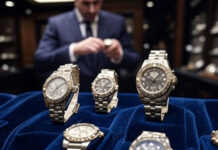In the world of luxury timepieces, few brands command the prestige and recognition of Rolex. Known for their precision, craftsmanship, and timeless design, Rolex watches are coveted by collectors and enthusiasts alike. However, the allure of owning a Rolex has given rise to a troubling trend: the proliferation of high-quality rolex replica watches. These counterfeit timepieces, often indistinguishable from the genuine article to the untrained eye, have become a significant issue for the luxury watch industry, raising concerns about authenticity, brand integrity, and consumer trust.
The Rise of Sophisticated Counterfeits
The market for counterfeit luxury goods is nothing new, but recent advancements in manufacturing technology have elevated the quality of rolex replica watches to unprecedented levels. Unlike the poorly made fakes of decades past, today’s replicas are crafted with remarkable attention to detail. From the weight of the watch to the intricate engravings on the bezel, these counterfeit pieces are designed to deceive even seasoned collectors. Some replicas even incorporate materials and movements that mimic the functionality of genuine Rolex watches, making detection increasingly difficult.
According to a recent report by the International Trademark Association (INTA), the global trade in counterfeit goods is estimated to be worth over $500 billion annually, with luxury watches accounting for a significant portion of this illicit market. The rise of e-commerce and online marketplaces has further fueled the spread of these fakes, allowing sellers to reach a global audience with relative anonymity.
The Impact on the Luxury Watch Industry
The influx of high-quality replicas poses a significant threat to brands like Rolex, which have built their reputation on exclusivity and craftsmanship. For consumers, purchasing a counterfeit watch—whether knowingly or unknowingly—can lead to disappointment, financial loss, and a diminished perception of the brand. For Rolex, the presence of fakes in the market undermines the value of their meticulously crafted timepieces and erodes the trust that customers place in the brand.
Industry experts note that the proliferation of replicas also affects the secondary market for luxury watches. Pre-owned Rolex watches are highly sought after, often commanding prices close to or exceeding their original retail value. However, the presence of sophisticated fakes has made buyers more cautious, leading to increased scrutiny and a demand for authentication services. This has driven up costs for legitimate sellers and created additional hurdles in the resale process.
Efforts to Combat Counterfeiting
Rolex and other luxury watchmakers have taken aggressive steps to combat the spread of counterfeit goods. The company works closely with law enforcement agencies, customs officials, and intellectual property organizations to identify and seize fake watches before they reach the market. In recent years, Rolex has also invested in advanced anti-counterfeiting measures, such as unique serial numbers, micro-etchings, and proprietary technologies that are difficult to replicate.
In addition to brand-led initiatives, governments and international organizations have stepped up efforts to address the issue. In 2024, the European Union implemented stricter regulations on online marketplaces, requiring platforms to verify the authenticity of luxury goods sold through their sites. Similarly, U.S. authorities have increased penalties for trafficking in counterfeit goods, aiming to deter manufacturers and distributors of fake watches.
Despite these efforts, the battle against counterfeits remains an uphill one. The anonymity of online sales, combined with the global nature of the supply chain, makes it challenging to track and shut down counterfeit operations. Many replica manufacturers operate in regions with lax intellectual property enforcement, further complicating efforts to curb their activities.
Consumer Awareness and Education
One of the most effective tools in combating the spread of replicas is consumer education. Rolex has launched campaigns to raise awareness about the risks of purchasing counterfeit watches, urging buyers to purchase only from authorized dealers. The company’s website provides detailed guidance on how to identify genuine Rolex watches, including tips on checking serial numbers, examining the movement, and verifying the authenticity of the packaging.
Watch enthusiasts are also playing a role in spreading awareness. Online forums and communities, such as Watchuseek and Reddit’s r/Watches, have become valuable resources for collectors seeking to authenticate their purchases. These platforms offer advice on spotting fakes, recommending reputable sellers, and sharing stories of encounters with counterfeit watches.
Experts advise consumers to exercise caution when purchasing luxury watches, particularly from unofficial sources. “If a deal seems too good to be true, it probably is,” says Margaret Thompson, a certified watch appraiser. “A genuine Rolex is an investment, and buyers should always verify the authenticity of the seller and the watch before making a purchase.”
The Ethical and Economic Implications
Beyond the financial impact, the trade in counterfeit watches raises ethical concerns. Many replica manufacturers operate in unregulated environments, where labor conditions and environmental standards are often overlooked. The production of fake watches can involve exploitative practices, including low wages and unsafe working conditions, which stand in stark contrast to the ethical standards upheld by brands like Rolex.
Moreover, the revenue generated from counterfeit goods often funds other illicit activities, including organized crime. By purchasing a fake watch, consumers may inadvertently contribute to a broader network of illegal operations, further perpetuating the cycle of counterfeiting.
Economically, the counterfeit market diverts revenue from legitimate businesses, impacting not only luxury brands but also the retailers, artisans, and supply chain partners who rely on the industry. The loss of revenue can stifle innovation and investment in new designs, ultimately harming the consumer experience.
The Future of Authenticity in Luxury Watches
As technology continues to evolve, so too do the methods used by counterfeiters. However, the same technological advancements are also empowering brands to stay one step ahead. Blockchain technology, for instance, is being explored as a means of creating tamper-proof records of authenticity for luxury goods. By assigning a unique digital certificate to each watch, brands like Rolex could provide buyers with an indisputable way to verify their purchase.
Artificial intelligence is also playing a role in the fight against counterfeits. AI-powered image recognition tools can analyze the details of a watch—such as the font on the dial or the texture of the bezel—to identify subtle differences that distinguish a genuine piece from a fake. These tools are being adopted by auction houses, retailers, and authentication services to streamline the verification process.
Looking ahead, the luxury watch industry faces the challenge of balancing innovation with tradition. While brands like Rolex continue to invest in cutting-edge technologies to protect their products, they must also preserve the craftsmanship and heritage that define their identity. For consumers, the key lies in staying informed and vigilant, ensuring that their investment in a luxury timepiece is both authentic and rewarding.
Conclusion
The rise of high-quality Rolex replicas is a complex issue that touches on economics, ethics, and consumer trust. While the luxury watch industry continues to grapple with the challenges posed by counterfeiters, efforts to combat the problem are gaining momentum. Through a combination of advanced technology, stricter regulations, and consumer education, brands like Rolex are working to protect their legacy and ensure that the allure of their timepieces remains untarnished. For watch enthusiasts, the message is clear: authenticity matters, and vigilance is key in preserving the value of a true luxury timepiece.



